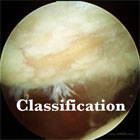|


|
synonyms: articular cartilage injury, Chondral Injury, chondromalacia
Chondral Injury ICD-10
Chondral Injury ICD-9
- 733.92(chondromalacia of medial or lateral compartments of the knee
- 717.7(chondromalacia of the patella)
Chondral Injury Etiology / Epidemiology / Natural History
- Synonyms:
- ICD-9=
- injury to mature articular cartilage
- articular cartilage does not regenerate. Lesions generally fill with biomechanically inferior fibrocartilage
- May progress to osteoarthritis
- Articular cartilage is made up of Type II collagen, proteoglycans, hyaluronic acid and chondrocytes
Cartilage Anatomy
- Articular cartilage is made up of chondrocytes(5%), type II collagen(10%), extracellular matrix proteoglycans(10%), noncollagenous proteins, and water(75%). The distribution of each component varies within four distinct histologic zones: superficial, middle, deep, and calcified
- Traumatic fracture of the chondral surface in skeletally mature pts occurs along the lines of the tidemark.
Chondral Injury Clinical Evaluation
- knee pain. Location of pain is dependent on location of defect
- Acute injuries often present with hemarthrosis (Noyes FR, JBJS 1980;62A:687)
Chondral Injury Xray
- Weight-Bearing A/P, and Lateral; eval for arthritic changes (osteophytes, joint narrowing, subchondral sclerosis) which are relative contraindications for restorative procedures.
- Long-leg alignment films are indicated if there is any concern for malalignments. Associated malalignment is a contraindication fo all surgical treatments for chondral injuries/chondromalacia.
- MRI: fat-suppressed and specialized fast-spin echo images are best to examine for chondral injury.
Grading systems for osteochondral damage (chondromalacia)
ICRS Grading
- www.cartilage.org
- Grade 0: normal
- Grade 1: Nearly Normal (soft indentation and/or superficial fissures and cracks
- Grade 2: Abnormal (lesions extending down to <50% of cartilage depth
- Grade 3: Severly Abnormal (carilage defects >50% of cartilage depth
- Grade 4: Severly abnormal (through the subchondral bone)
Outerbridge System
- Grade I: Softening and swelling of cartilage
- Grade II: Fragmentation and fissuring, less than 0.5-in diameter
- Grade III: Fragmentation and fissuring, greater than 0.5-in diameter
- Grade IV: Erosion of cartilage down to exposed subchondral bone
Noyes System
- Grade 1: Cartilage surface intact (1A = some remaining resilience; 1B = deformation)
- Grade 2A: Cartilage surface damaged (cracks, fibrillation, fissuring, or fragmentation); with less than half of cartilage thickness involved
- Grade 2B: Depth of involvement greater than half of cartilage thickness but without exposed bone
- Grade 3: Bone exposed (3A = surface intact; 3B = surface cavitation)
Chonral Injury Treatment
- Conservative: acetaminophen, NSAIDs, glucosamine/chondroitin, steroid/hyaluronic acid injection, unloader braces.
- <3cm2Grade IV lesion = osteochondral autograft.
- >3cm2Grade IV lesion = osteochondral allograft or autologous chondrocyte implantation or observation.
- Arthroscopy with lavage and debridement, ie Chondroplasty. (Levy AS, AJSM 1996;24:634)
- Microfracture (Steadman JR, Operative Techniques Orthop 1997;7:300), generally good for focal lesions <4cm2, low body mass index, and short duration of symptoms (Mithoefer K, JBJS 2005;87A:1911).
- Osteochondral autograft (OATS): typically defects <2.5cm. (Hangody L, JBJS Am, 2003;85(sup2):25).
- Osteochondral allograft: used for >10 cm2 full-thickness lesions after the failure of one or two previous surgical procedures. (Gross AE, Operative Techniques Orthop 1997;7:334), (Aubin PP, CORR 2001;391(sup):S318).
- Autologous chondrocyte implantation: typically defects > 2 cm2. (Peterson L, CORR 2000;374:212).
- Arthroplasty
- Associated malalignment must be corrected before any cartilage restoration procedure. Most isolated lesions involve the MFC and can be associated with varus alignment. Concomitant HTO is indicated.
Microfracture Technique
- (Steadman JR, J Knee Surg. 2002;15:170-6), (Mithoefer K, JBJS 2005;87A:1911).
- accurate débridement of all unstable and damaged cartilage in the lesion, including the calcified layer down to the subchondral bone plate. Removal of calcified cartilage layer greatly increases the percentage of defect fill.
- All loose or marginally attached cartilage débrided from the surrounding rim of the defect, to form a stable perpendicular edge of healthy cartilage.
- An arthroscopic awl used to make multiple holes in the defect, 3 to 4 mm apart starting at the periphery of the lesion. Holes must not be so close to each other that they could break into one another.
- Tourniquet deflated / pump pressure reduced to visualize blood, fat droplets / marrow elements coming from the holes.
- Postoperative continuous passive motion (CPM) and protected weight bearing for 6 to 8 weeks has similar clinical outcome to early weight bearing and no CPM (Marder RA, Arthroscopy 2005;21:152).
- Results similar to autologous chondrocyte implantation at 2 yr f/u. (Gunnar JBJS. 2004; 86A: 455-464)
Chondroplasty
- CPT=29877: G0289 should used if coding a chondroplasty with another procedure. Example: medial menisectomy with chondroplasties in the lateral and patellofemoral compartments would be coded 29881, G0289, G0289-59.
Chondral Injury Follow-up care
- Post-op: 6hrs/day CPM, NWB x6wks unless lesion treated was patellofemoral.
- 7-10 Days: Wound check, continue CPM, NWB
- 6 Weeks: Discontinue CPM, advance to full weight bearing
- 3 Months: Resume all normal ADLs.
- 6 Months: Gradually begin running / sport specific rehab.
- 1Yr: Return to sport / full duty. Return to high-impact activites after treatment of large defects is not recommened.
Chondral Injury Review Reference
- Browne JE, JAAOS 2000;8:180
- Alford JW, AJSM 2005;33:443
|


